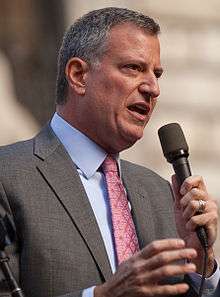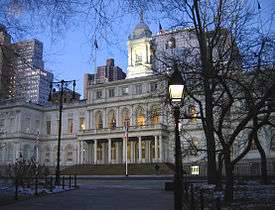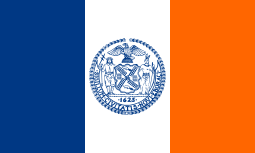Government of New York City
The government of New York City, headquartered at New York City Hall in Lower Manhattan, is organized under the New York City Charter and provides for a "strong" mayor-council system. The mayor is elected to a four-year term and is responsible for the administration of city government. The New York City Council is a unicameral body consisting of 51 members, each elected from a geographic district, normally for four-year terms. All elected officials are limited to a two consecutive-term limit.[1] The court system consists of two city courts and three state courts.
New York City government employs 325,000 people, more than any other city in the United States and more than any U.S. state but three: California, Texas, and New York.[2] The government is more centralized than that of most other U.S. cities, with the city government being responsible for public education, correctional institutions, public safety, recreational facilities, sanitation, water supply, and welfare services.[3] New York City's political geography is unique, consisting of five boroughs, each coterminous with one of five counties of New York State: Brooklyn is Kings County, The Bronx is Bronx County, Manhattan is New York County, Queens is Queens County, and Staten Island is Richmond County. When New York City was consolidated into its present form in 1898, all previous town and county governments within it were abolished in favor of the present five boroughs and a unified, centralized city government.[4] However, each county retains its own district attorney to prosecute crimes, most of the court system is organized around the counties, and only three public libraries represent the city's five boroughs, namely: Brooklyn Public Library (located in Brooklyn), New York Public Library (located in the Bronx, Manhattan, and Staten Island), and Queens Public Library (located in Queens).
Executive branch
The executive branch of New York City consists of the Mayor, and numerous departments, boards and commissions. The Mayor also appoints several deputy mayors to head major offices within the executive branch of the city government. The City Record is the official journal published each weekday (except legal holidays) containing legal notices produced by city agencies,[5][6] and regulations are compiled in the Rules of the City of New York.[7]
Mayor

The Mayor is the chief executive officer of the city and a magistrate,[8][9] appoints and removes all unelected officers and exercise all the powers vested in the city except otherwise provided by law,[10][9] and is responsible for the effectiveness and integrity of city government operations.[9] The mayor is directly elected by popular vote for a four-year term.
Departments
Other citywide offices
Along with the mayor, the Public Advocate and the Comptroller are the only three directly elected citywide officials in New York City.
Public Advocate
The Public Advocate is an elected official with responsibility to ease public relations with the government, investigate complaints regarding city agencies, mediate disputes between city agencies and citizens, serve as the city's ombudsman and advise the mayor on community relations.[11] The Public Advocate is a member of the Council.[12] The Public Advocate stands first in line of succession to the mayoralty.[11]
Comptroller
The Comptroller conducts performance and financial audits of all city agencies, serves as a fiduciary to the city's five public pension funds totaling nearly $160 billion in assets, provides comprehensive oversight of the city's budget and fiscal condition, reviews city contracts for integrity, accountability and fiscal compliance, manages the fair, efficient and effective resolution of claims against the city, ensures transparency and accountability in the prevailing wage rate-setting process and enforces prevailing wage and living wage laws.[13][14] The Comptroller stands second, after the Public Advocate, in the line to succeed a mayor who has become unable to serve.
Legislative branch
Legislative power in the City of New York is vested in the New York City Council. The New York State Constitution empowers local governments to adopt local laws in addition to ordinances, resolutions, rules and regulations.[15][16][17]

The Council is a unicameral body consisting of 51 Council members, whose districts are defined by geographic population boundaries that each contain approximately 157,000 people. Council members are elected every four years, except that after every census held in years divisible by twenty, districts are redrawn, requiring two consecutive two-year terms, the second of which is held in the redrawn districts. The Speaker of the Council, selected by the 51 Council members, is often considered the second most powerful post in New York City's government after the Mayor.
Bills passed by a simple majority are sent to the mayor, who may sign them into law. If the mayor vetoes a bill, the Council has 30 days to override the veto by a two-thirds majority vote. A local law has a status equivalent with a law enacted by the New York State Legislature (subject to certain exceptions and restrictions[18]), and is superior to the older forms of municipal legislation such as ordinances, resolutions, rules and regulations.[17] The codified local laws of New York City are contained in the New York City Administrative Code.[19][20]
The Council has several committees with oversight of various functions of the city government. Each council member sits on at least three standing, select or subcommittees. The standing committees meet at least once per month. The Speaker of the Council, the Majority Leader, and the Minority Leader are all ex officio members of every committee.
Courts
The New York City court system consists of two citywide courts, the Criminal Court and the Civil Court, and several statewide courts, the Supreme Court, Surrogate's Court, and Family Court. Unlike the rest of New York, New York City counties do not have a typical County Court. Each state court is located in each of New York City's five counties (boroughs). There are also several extrajudicial administrative courts, which are executive agencies and not part of the state Unified Court System.

The Criminal Court of the City of New York handles misdemeanors (generally, crimes punishable by fine or imprisonment of up to one year) and lesser offenses, and also conducts arraignments (initial court appearances following arrest) and preliminary hearings in felony cases.[21][22]
The Civil Court of the City of New York decides lawsuits involving claims for damages up to $25,000 and includes a small claims part for cases involving amounts up to $5,000 as well as a housing part for landlord-tenant matters, and also handles other civil matters referred by the Supreme Court.[21][22] It handles about 25% of all the New York state and local courts' total filings.[23]
There are also several other county-by-county state courts. The Supreme Court of the State of New York is the trial court of general jurisdiction, which in New York City hears felony cases and major civil cases.[24] (Lesser criminal and civil cases are heard in the Criminal Court and Civil Court, respectively.) The Family Court of the State of New York is a family court that hears cases involving children and families.[25] The Surrogate's Court of the State of New York is the probate court which oversees the probate of wills and administers estates.
There are also several extrajudicial administrative courts. The Office of Administrative Trials and Hearings adjudicates matters for all city agencies unless otherwise provided for by executive order, rule, law or pursuant to collective bargaining agreements. The Department of Finance Adjudication Division (Parking Violations Bureau) adjudicates parking violations, the Department of Consumer Affairs Adjudication Division (DCA Tribunal) adjudicates disputes between businesses and the DCA or consumers as well as some licensing cases, and the Tax Appeals Tribunal adjudicates disputes regarding city-administered taxes other than real estate assessment claims, which are adjudicated by the city Tax Commission. The state DMV Traffic Violations Bureau adjudicates non-parking traffic violations.
County, borough and community government
New York City is composed of five boroughs or counties, collectively comprising 59 community districts.[26]
District attorneys
Each of the five counties of New York City elects a district attorney for a four-year term,[27] whose duty it is to prosecute all crimes and offenses cognizable by the courts of the county.[28]
Political parties
The Election Law defines the structure of political parties and requires each party to have county committees (and a state committee).[29][30][31] The county committees are composed of at least two members elected from each election district (containing a maximum of 950–1150 registered voters), as well as two members elected from each assembly district within the county (district leaders).[32][31] The political party's county executive committees typically select candidates for local offices.[31] Judicial nominating conventions nominate New York Supreme Court justices.[33]
Borough presidents
Each of the five boroughs has an elected borough president.[34] The borough presidents can have legislation introduced in the council, recommend capital projects, hold public hearings on matters of public interest, make recommendations to the mayor and to other city officials, make recommendations on land use and planning, and make recommendations regarding the performance of contracts providing for the delivery of services, in the interests of the people of their borough.[35]
Borough boards
Each of the five boroughs has a borough board.[36] They are composed of the borough president, Council members from the borough, and the chairperson of each community board in the borough.[36] The borough boards can hold or conduct public or private hearings, adopt by-laws, prepare comprehensive and special purpose plans and make recommendations for land use and planning, mediate disputes and conflicts among two or more community districts, submit a comprehensive statement of the expense and capital budget priorities and needs, evaluate the progress of capital developments and the quality and quantity of services provided by agencies, and otherwise consider the needs of the borough.[37]
Community boards
Each of the fifty-nine community districts has a community board composed of up to 50 volunteer members appointed by the local borough president, half from nominations by City Council members representing the community district (i.e., whose council districts cover part of the community district).[38][39] Community boards advise on land use and zoning, participate in the city budget process, and address service delivery in their district.[40] Community boards act in an advisory capacity, wielding no official authority to make or enforce laws.[39][40]
Heraldry


The seal of New York City, adopted in an earlier form in 1686, bears the legend SIGILLVM CIVITATIS NOVI EBORACI, which means simply "The Seal of the City of New York". Eboracum was the Roman name for York, the titular seat of James II as Duke of York. The two supporters represent the unity between Native Americans and colonists, the four windmill sails recall the city's Dutch history as New Amsterdam, and the beavers and flour barrels the city's earliest trade goods (see History of New York City). The crest over the seal is the American eagle, added after the American Revolution. "1625", at the bottom, is the date the city was founded.
The flag of New York City was adopted in 1915. Its blue, white, and orange bands represent the colors of the Dutch flag that flew over the city, then New Amsterdam, between the 1620s and 1660s. Located in the center is a blue print of the official Seal of New York City.
The Mayor's Office has its own official flag as well, which is the same design with an added five-pointed star (representing each of the five boroughs) in blue.
See also
- Government and politics in Brooklyn
- Government of New York (state)
- List of New York City Borough Halls and municipal buildings
- Politics of New York City
References
- ↑ Chan, Sewell; Hicks, Jonathan P. (October 23, 2008). "Council Votes, 29 to 22, to Extend Term Limits". The New York Times.
- ↑ http://www.cepr.net/documents/publications/wage-penalty-2010-05.pdf
- ↑ "New York City Charter" (PDF). City of New York. July 2004. Retrieved 2009-07-19.
- ↑ Local Government Handbook (PDF) (6th ed.). New York State Department of State. 2009. p. 56.
- ↑ "About DCAS - The City Record". New York City Department of Citywide Administrative Services. Retrieved 13 June 2014.
- ↑ Durkin, Erin (26 May 2014). "Councilman Ben Kallos wants city to publish government notices on its website". New York Daily News.
- ↑ Gibson & Manz 2004, p. 473.
- ↑ New York City Charter § 3
- 1 2 3 New York City Charter § 8
- ↑ New York City Charter § 6
- 1 2 "About the Office". New York City Public Advocate. Retrieved 3 December 2014.
- ↑ New York City Charter § 22
- ↑ "The Duties of the Comptroller". New York City Comptroller. Retrieved 4 December 2014.
- ↑ New York City Charter § 93
- ↑ Gibson, Ellen M.; Manz, William H. (2004). Gibson's New York Legal Research Guide (PDF) (3rd ed.). Wm. S. Hein Publishing. p. 258. ISBN 1-57588-728-2. LCCN 2004042477. OCLC 54455036.
- ↑ Adopting Local Laws in New York State (PDF). James A. Coon Local Government Technical Series. New York State Department of State. May 1998. pp. 1–3.
- 1 2 NYSDOS 1998, p. 10.
- ↑ NYSDOS 1998, pp. 3-10.
- ↑ Gibson & Manz 2004, p. 450.
- ↑ Gibson & Manz 2004, p. 458.
- 1 2 The New York State Courts: An Introductory Guide (PDF). New York State Office of Court Administration. 2000. p. 4. OCLC 68710274.
- 1 2 The New York State Courts: An Introductory Guide (PDF). New York State Office of Court Administration. 2010. p. 2. OCLC 668081412.
- ↑ "Civil Court History". New York State Office of Court Administration. Retrieved 17 August 2014.
- ↑ State of New York Judiciary Budget: FY 2014-15 (PDF). p. 18.
- ↑ Introductory Guide to the New York City Family Court (PDF). Committee on Family Law and Family Court of the Association of the Bar of the City of New York. February 2012. p. 1.
- ↑ "Community District Information". New York City Department of City Planning. Retrieved 3 December 2014.
- ↑ County Law
- ↑ County Law
- ↑ Election Law article 2
- ↑ Zimmerman, Joseph F. (2008). The Government and Politics of New York State (2nd ed.). SUNY Press. ISBN 978-0-7914-7435-8.
- 1 2 3 Zimmerman 2008, p. 55.
- ↑ Election Law
- ↑ New York City Bar Association Council on Judicial Administration (March 2014). Judicial Selection Methods in the State of New York: A Guide to Understanding and Getting Involved in the Selection Process (PDF). New York City Bar Association. pp. 23–27.
- ↑ New York City Charter § 81
- ↑ New York City Charter § 82
- 1 2 New York City Charter § 85(a)
- ↑ New York City Charter § 85(b)
- ↑ New York City Charter § 2800(a)
- 1 2 "About Community Boards". NYC Mayor's Community Affairs Unit. Retrieved 26 November 2016.
- 1 2 Berg, Bruce (2007). New York City Politics: Governing Gotham. Rutgers University Press. p. 277.
External links
| Wikimedia Commons has media related to Government of New York City. |
- NYC.gov
- New York City Charter, the New York City Administrative Code, and the Rules of the City of New York from New York Legal Publishing
- Checkbook NYC 2.0 from the New York City Comptroller
- NYC Open Data from the New York City DoITT and Socrata
- City of New York on GitHub